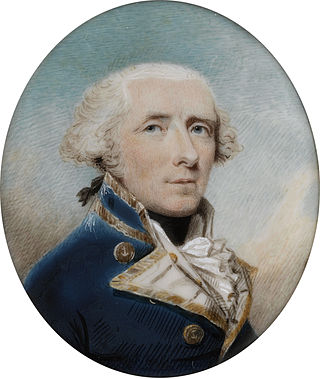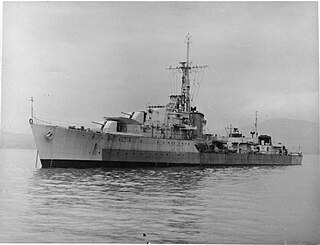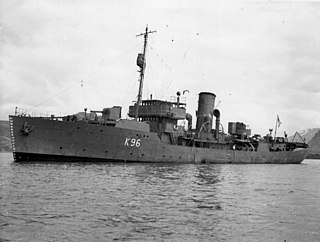
HMS Minden was a Royal Navy 74-gun Ganges-class third-rate ship of the line, launched on 19 June 1810 from Bombay, India. She was named after the German town Minden and the Battle of Minden of 1759, a decisive victory of British and Prussian forces over France in the Seven Years' War. The town is about 75 km away from Hanover, from where the House of Hanover comes—the dynasty which ruled the United Kingdom from 1714 until 1901.

HMS Liverpool was a fourth-rate frigate of the Royal Navy.

HMS Royal Sovereign was a 100-gun first-rate ship of the line of the Royal Navy, which served as the flagship of Admiral Collingwood at the Battle of Trafalgar. She was the third of seven Royal Navy ships to bear the name. She was launched at Plymouth Dockyard on 11 September 1786, at a cost of £67,458, and was the only ship built to her design. Because of the high number of Northumbrians on board the crew were known as the Tars of the Tyne.

HMS Scarborough was a Hastings-class sloop of the Royal Navy launched in 1930. She served in the Second World War, especially as a convoy escort in the North Atlantic.

HMS Caledonia was a broadside ironclad of the Prince Consort class. Originally laid down as a two-decker steam ship of the line of the Bulwark class, Caledonia was converted on the building stocks into an armoured frigate.

HMS Investigator was the mercantile Fram, launched in 1795, which the Royal Navy purchased in 1798 and renamed HMS Xenophon, and then in 1801 converted to a survey ship under the name HMS Investigator. In 1802, under the command of Matthew Flinders, she was the first ship to circumnavigate Australia. The Navy sold her in 1810 and she returned to mercantile service under the name Xenophon. She was probably broken up c.1872.

Admiral Skeffington Lutwidge was an officer of the Royal Navy who saw service during the American War of Independence, and the French Revolutionary and Napoleonic Wars. He had a particular connection with Horatio Nelson, who served under Lutwidge as a midshipman on an expedition to the Arctic in HMS Carcass in 1773, and again in 1801 while a captain, when Lutwidge was commander in chief in the Downs. Lutwidge served for a considerable period and in a number of ships, in American waters during the War of Independence. During this time he captured a number of American privateers, and was involved in operations on Lake Champlain. He reached flag rank soon after the start of the French Revolutionary Wars, and served mainly in Home waters as commander in chief of some of the stations on the south coast. He retired from active service with the rank of admiral, and died in 1814, shortly before the end of the Napoleonic Wars. He was the great-uncle of Lewis Carroll.

HMS Tower was a modified R-class destroyer of the Royal Navy, named after the White Tower of the Tower of London. She was built by Swan Hunter, and launched on 5 April 1917. She is noted for having the first modern Royal Navy ship's badge. She served as part of the Grand Fleet and Harwich Force.
Admiral Sir Lawrence William Halsted GCB was an officer of the Royal Navy who served during the American War of Independence and the French Revolutionary and Napoleonic Wars.
The Conway class sailing sixth rates were a series of ten Royal Navy post ships built to an 1812 design by Sir William Rule. All ten were ordered on 18 January 1812, and nine of these were launched during 1814, at the end of the Napoleonic War; the last (Tees) was delayed and was launched in 1817.
Empire Conveyor was a 5,911 GRT shelter deck cargo ship that was built in 1917 as Farnworth by Richardson, Duck and Company, Thornaby-on-Tees, England. After a sale in 1924 she was renamed Illinois. In 1926, she was sold to France, and in 1934 to Greece and was renamed Mount Pentelikon. In 1939, she was sold to Germany and was renamed Gloria.

HMS Ambrose was a steamship that was built for in 1903 as a passenger liner. The Booth Steam Ship Company ran her scheduled on services between Liverpool and Brazil until the First World War.
Robert Murray was an officer in the Royal Navy who served during the American War of Independence and the French Revolutionary and Napoleonic Wars.

HMS Columbine was a Cruizer-class brig-sloop launched in 1806. She served on the North America station, in the Mediterranean, off the Portuguese coast, and in the West Indies during the Napoleonic Wars. In 1823 she served briefly off Greece before wrecking off the Peloponnese in 1824.

HMS Zenith was a Z-class destroyer of the Royal Navy built as by William Denny and Brothers, Dunbarton. She was ordered as part of the 10th Emergency Flotilla, and was originally to have been named HMS Wessex. She spent her first ten years in Royal Navy service, before being sold to the Egyptian Navy, which operated her as El Fateh. She was a training ship until 2014, and her name was transferred to a new vessel in 2017, but she remains listed by the IISS.

HMS Arethusa was a 46-gun Leda-class fifth-rate frigate built for the Royal Navy during the 1810s. The ship was never commissioned and was converted into a lazarette in 1836. She was renamed HMS Bacchus in 1844 and was further converted into a coal hulk in 1851–52. The ship was sold for scrap in 1883.
HMS Medusa was one of three 2-gun Merlin-class paddle packet boat built for the Royal Navy during the 1830s. She was converted into a tugboat in 1861–1862 and sold for scrap in 1872.
Irlam was a West Indiaman launched in Liverpool in 1813 for Barton & Co., which had lost an earlier Irlam in 1812. The current Irlam was of the same burthen as her predecessor, and was employed in the same trade, Liverpool to Barbados. She was wrecked in January 1824.

HMS Aubrietia (K96) was a Flower-class corvette built for the Royal Navy (RN) from 1941-1946. She was active as a convoy escort in the Atlantic and Mediterranean. In May 1941, Aubrietia sighted and depth charged the German submarine U-110, leading to its capture and the seizure of a German Naval Enigma and its Kurzsignale code book.
Four vessels of the Royal Navy have been named HMS Tees after the River Tees:













